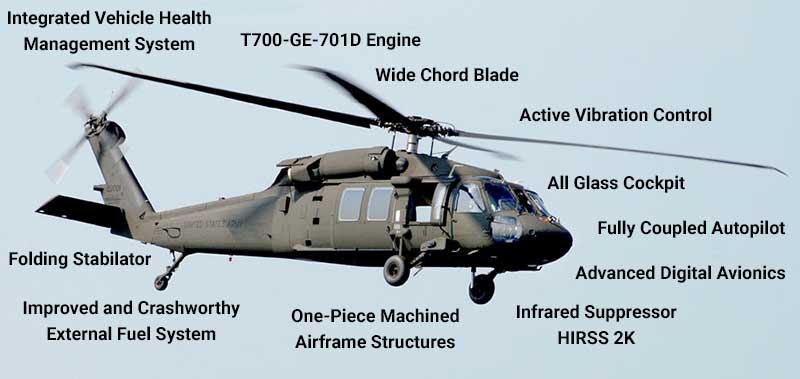Recognizing the Mechanics and Engineering Behind Uh 60 Helicopters
The UH-60 helicopter, typically understood as the Black Hawk, stands as a pinnacle of contemporary rotorcraft innovation, personifying a blend of durable engineering and complex auto mechanics. As we peel off back the layers of the UH-60's style, a world of complex systems and careful design comes to light.
Background of UH-60 Helicopters
The history of UH-60 helicopters traces back to the late 1970s when the United States Military looked for a advanced and versatile energy helicopter to replace its aging fleet. In reaction to this need, the Sikorsky Aircraft Company established the UH-60 Black Hawk helicopter. Introduced in 1979, the UH-60 promptly came to be a staple in armed forces operations due to its outstanding capabilities.
The UH-60 was made to succeed in a range of missions, consisting of army transport, medical evacuation, electronic warfare, and unique procedures. Its ability to adjust to different duties made it a valuable property to the U.S. uh 60. Military and other army pressures around the globe
Throughout the years, the UH-60 system has actually undergone numerous upgrades and variants to improve its efficiency and keep rate with progressing objective demands. These helicopters have actually seen considerable service in problems such as the Gulf War, Afghanistan, and Iraq, showcasing their reliability and versatility in diverse functional environments. The UH-60's abundant background is a testament to its enduring legacy as a leading energy helicopter.

Engine and Power Solutions
Making use of sophisticated propulsion modern technology, UH-60 helicopters are outfitted with innovative engine and power systems to make sure ideal efficiency and reliability in a series of operational circumstances. The UH-60, generally recognized as the Black Hawk, is powered by two General Electric T700-GE-701D engines, each capable of delivering up to 1,940 shaft horsepower. These turboshaft engines give the needed thrust for the helicopter to execute its objectives successfully, consisting of troop transport, clinical evacuation, and combat assistance.

Rotor System and Aerodynamics
Just how do the blades system and aerodynamics of UH-60 helicopters contribute to their functional effectiveness and trip capacities? The rotor system of the UH-60 helicopter plays an important role in providing lift and propulsion.
The rules of aerodynamics additionally play a vital duty in the performance of UH-60 helicopters. The streamlined body and rotor blade design reduce drag, allowing the helicopter to attain higher rates and navigate to this site far better fuel performance. The wind resistant design of the UH-60 additionally adds to its ability to run in diverse environmental problems, including high altitudes and warm temperatures.
Avionics and Flight Control Equipment

In its complex coordination with the blades system and the rules of aerodynamics of UH-60 helicopters, the avionics and trip control systems form a critical network of innovations forming the aircraft's functional capacities. Avionics include the digital systems made use of for interaction, navigation, and keeping an eye on numerous airplane features. In the UH-60, these systems include electronic displays, communication radios, general practitioner navigating, weather condition radar, and auto-pilot systems. These avionics systems provide critical information to the pilots, improving situational understanding and guaranteeing effective and secure procedure of the helicopter.
The trip control systems of the UH-60 are accountable for translating the pilot's inputs into the suitable modifications to the blades system, ensuring steady flight and maneuverability. These systems include hydraulic actuators, servos, and computer systems that interact to control the major and tail rotors, in addition to various other trip control surfaces. By precisely managing the helicopter's flight dynamics, these systems enable pilots to execute a variety of goals, from transportation and search-and-rescue to battle procedures, with accuracy and self-confidence.
Duty and Applications in Aeronautics
Avionics systems in UH-60 helicopters include a range of digital systems that aid in navigation, interaction, monitoring, and controlling different airplane functions. These systems consist of digital display screens, auto-pilot systems, communication radios, General practitioner navigating devices, and climate radar. Additionally, these systems incorporate safety and security features such as auto-pilot settings, terrain recognition cautioning systems, and security augmentation systems to boost the general safety and Source security and operational abilities of the UH-60 helicopters in numerous missions, consisting of army transportation, medical emptying, search and rescue, and airborne firefighting.
Final Thought
Finally, the UH-60 helicopter is a flexible airplane with an abundant background and advanced engineering. Its engine and power systems, blades system, the rules of aerodynamics, avionics, and trip control systems all collaborate to make it a reliable and effective machine. The UH-60's role and applications in aviation are large, varying from army operations to browse and rescue goals. Its proceeded development blog here and use demonstrate its value in the area of aeronautics (uh 60).
In its intricate coordination with the rotor system and the rules of aerodynamics of UH-60 helicopters, the avionics and trip control systems develop a critical network of modern technologies shaping the aircraft's operational capacities.The trip control systems of the UH-60 are accountable for equating the pilot's inputs into the suitable adjustments to the rotor system, guaranteeing stable trip and ability to move. Avionics systems in UH-60 helicopters include a variety of digital systems that help in navigation, interaction, tracking, and regulating various aircraft features. In addition, these systems integrate safety and security functions such as auto-pilot settings, surface awareness alerting systems, and security enhancement systems to improve the overall security and operational capabilities of the UH-60 helicopters in various objectives, including troop transport, medical evacuation, search and rescue, and aerial firefighting.
Its engine and power systems, blades system, aerodynamics, avionics, and flight control systems all function together to make it a reliable and trusted machine.